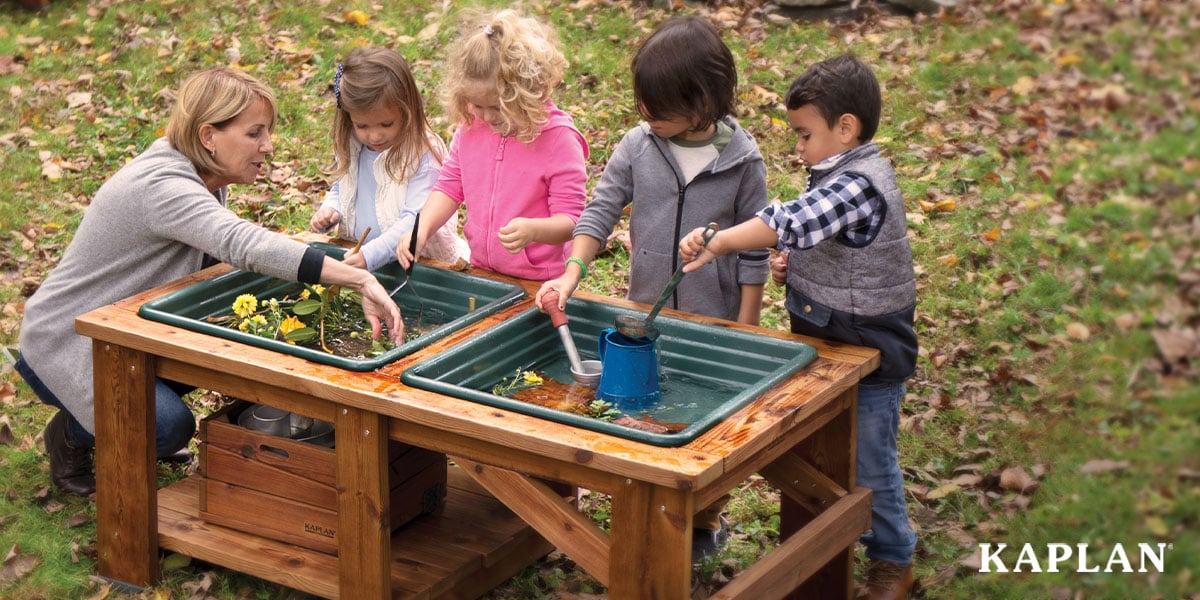Like the inside of your classroom, your outdoor environment can support child development and learning. Whether you are creating a new outdoor environment from scratch or updating your existing playgrounds, your goal is to create a space that meets children's developmental needs and provides more opportunities for play beyond what they get from large equipment and climbing structures.
This article will outline five ways children play while outdoors, according to the early childhood research from environmental design experts Dr. Sandra Duncan and Clare Nugent, and how you can create outdoor environments that support those play patterns and children's interactions with nature.
What are the different ways in which children play while outdoors?
How children play outdoors is similar to how they play in the classroom. They are still curious, imaginative, and full of active energy. However, with the space and surroundings that nature provides, you may notice that children do much more than climb and run around on large playground equipment. While outdoors, children often exhibit these patterns of play:- Collectors - Collecting flowers, rocks, acorns, feathers, and other natural items
- Diggers - Digging and building structures from blocks or found materials
- Transformers - Transforming materials into something new for artistic or creative purposes
- Storytellers - Using the outdoor environment to tell stories or play pretend
- Investigators - Investigating and exploring objects or outdoor occurrences
How can you create outdoor environments that support children's unique play patterns?
When you think about an early childhood playground, you probably imagine large play equipment, slides, and climbing structures. While it is true that children can investigate, collect, and play pretend in outdoor spaces that contain only these items, they flourish when given the appropriate environment and materials to fully support their play patterns.
 Environments to engage the collectors:
Environments to engage the collectors:
A collector finds joy in picking up objects and collecting them, sometimes for a structure they want to build or an art project they want to create, other times as a gift for a parent or classmate. To create outdoor environments that engage collectors, incorporate baskets, buckets, or cups for gathering. Place the baskets and buckets near growing flowers and evergreen shrubs that children can harvest for their collections.
 Environments to engage the diggers:
Environments to engage the diggers:
Children who love to dig often gravitate towards an outdoor sandbox or dirt-filled area on the playground. They find joy in getting their hands dirty, using tools to do forceful work, and discovering items hidden in the earth. You can create areas dedicated to digging by placing a raised garden bed, sandbox, or a simple mound of dirt in a shady area away from the heavy traffic areas of your playground. To inspire this play pattern, provide children with scooping tools, construction vehicles, loose parts to bury and discover, and other digging-approved play materials.
 Environments to engage the transformers:
Environments to engage the transformers:
While some children love to collect and admire objects they find outdoors, others like to transform those objects into something else. They may mix dirt, leaves, and sticks into a bowl of "mud soup" or crush flower petals to use as paint. Incorporating items such as a mud kitchen, outdoor easel, or child-sized bowls in your outdoor play areas is a great way to encourage this type of play while outdoors.
 Environments to engage the storytellers:
Environments to engage the storytellers:
As the name suggests, storytellers are children who love using their imagination while outdoors. You may find them running around the playground pretending to chase dinosaurs or standing on a platform singing a song for all to hear. Environments that engage storytellers should incorporate intentional places where children can engage in dramatic play. Natural structures, creative play equipment, and raised platforms are great ways to encourage children to use their imagination while outdoors.
 Environments to engage the investigators:
Environments to engage the investigators:
Most children are naturally curious and love exploring and asking questions to better understand their environment. They enjoy watching insects munch on leaves and birds fly in the sky and are not afraid to ask question after question whenever they experience something new. Incorporate reflective surfaces and ground-level seating in your outdoor environments to give children a comfortable place to make observations. You can also provide specimen containers and science journals where children can study and record their observations.
Get inspiration for your outdoor environments!
As you can see, your playground and outdoor environments can be so much more than a space for large equipment, swings, and climbing structures. With the right materials and encouragement, you can help children engage in outdoor play that is both fun and educational. Read this article to see how Carver Daycare and Preschool in Evansville, Indiana, transformed their outdoor environments to extend child learning beyond the classroom. 

